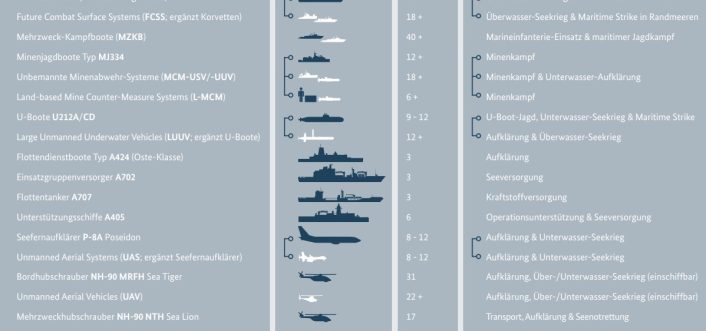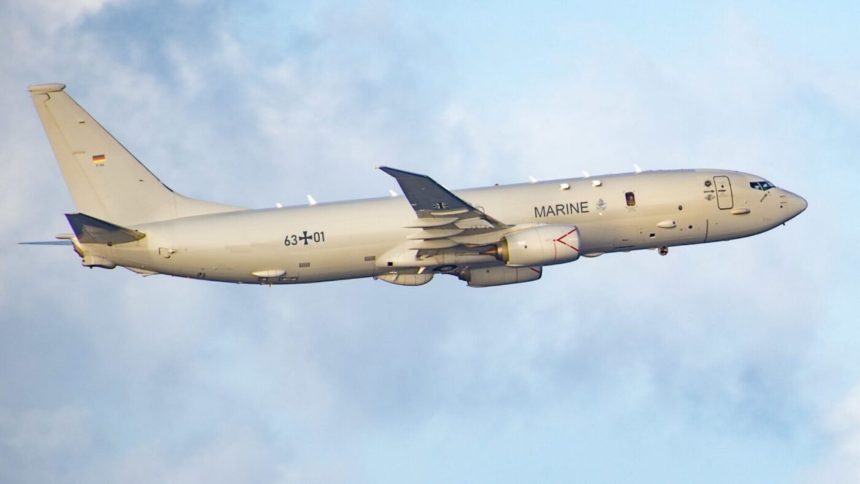Germany has already eight P-8A Poseidons on contract, the first of which is expected to be delivered this year.
Germany is likely to ask for additional four P-8A Poseidon Multimission Maritime Aircraft (MMA), based on the funding sought in latest defense budget requests and the Bundeswehr’s latest naval plan – the Kurs Marine 2025. The country has already ordered eight Poseidons and the additional planned purchase, if approved, would be in line with enhanced roles within NATO in the North Atlantic and the North Seas.
This could also mark the natural death of the Franco-German Maritime Airborne Warfare System (MAWS) program intended to develop substitutes for the two countries’ aging Breguet Atlantique ATL2s and P-3C Orions. Only two German P-3Cs remain in service, as well as 22 French Atlantique 2.
The Bundeswehr revealed in February 2025 the first of the German Navy’s (Deutsche Marine) eight Boeing P-8As, sporting full German colors and markings at Boeing’s factory in Seattle, Washington. Bearing the tail number 170528 and registration 63+01, this was the first of eight aircraft that Berlin contracted in a recent Foreign Military Sales (FMS) program and is due to reach Germany in a few months, following functionalities’ testing.
The Procurement Agency for the German Armed Forces (BAAINBw) and the German Navy stopped by the #P8 finishing center to check on the progress of their first P-8A Poseidon. Hear why the service says it’ll be an “awesome feeling” to receive the first sub hunter later this year. pic.twitter.com/w3tyGpn3GA
— Boeing Defense (@BoeingDefense) July 15, 2025
Draft budget
Hartpunkt reported on Aug. 22, 2025, an allocation request of €2.8 billion in “commitment appropriations” in the 2026 budget framework, earmarked for the P-8A in the years from 2028 to 2032. The report contrasts this figure with the significantly lower €700 million in the 2025 draft budget for the years from 2028 to 2030 submitted to the Parliament (Bundestag).
The first five aircraft were contracted in June 2021 for €1.43 billion, with three more worth €1.1 billion added in November 2023. This has led observers to conclude that this jump in commitment authorizations is not only meant for equipment like buoys, torpedoes, or simulators for the P-8A, “but also additional aircraft.”
“Experts have reported that the Navy has an additional need for at least four additional maritime patrol aircraft of this type,” Hartpunkt added.
First @BoeingDefense P-8 #Poseidon for the German Naval Air Arm @deutschemarine has made its first flight in Seattle. Delivery is planned for August. pic.twitter.com/pNktIrLilN
— Tony Osborne (@Rotorfocus) February 27, 2025
Lastly, the Kurs Marine 2025 envisages the P-8A operating alongside unmanned fixed-wing and rotary-wing aircraft, along with naval utility helicopter variants of the NH-90, beyond 2029 and beyond 2035. In another illustrative chart listing the German Navy’s “target inventory” by 2035, the number of P-8As, along with a MALE-class drone that resembles the MQ-9B SeaGuardian, has been increased from the previous eight, to “8-12.”
These are classified as “Reconnaissance & Underwater Warfare” systems. Those systems in the chart colored white are the ones Germany presently has not yet acquired, and it indicates that it is eyeing U.S.-made UAVs and might make a decision in the future.
While Hartpunkt clarifies that the budget has yet to be approved, the Bundeshwehr’s intent to increase its P-8A fleet is clear. If it decides to do so, it would have to begin with submitting the letter of intent to the U.S. government to initiate the FMS (Foreign Military Sales) route.

German-French MAWS program
The Bundeswehr said in 2021 that the acquisition of the P-8As was an interim solution to meet the ten-year capability gap that would arise after retiring the P-3Cs by 2025 and the Franco-German Maritime Airborne Warfare System (MAWS) not scheduled to come online by 2035. The MAWS project envisaged Airbus and Dassault Aviation jointly developing a successor to the P-3C and the Breguet Atlantique ATL2.
In September 2023, Germany approved the sale of six of its eight P-3C CUP (Capability Upgrade Program) Orions to Portugal for $48.5 million, which Lisbon received on Feb. 9, 2024. The P-3C Orions were operated by the 3rd Naval Air Wing “Graf Zeppelin” at Nordholz in the northeast. Only two P-3C Orions are currently operational until the Poseidons arrive.
In the intervening period, Germany also declined the French offer of four ATL2s upgraded to Standard 6, dealing a blow to the MAWS. Little has moved forward since then.
Airbus then unveiled the A321 MPA (Maritime Patrol Aircraft) in November 2024 and launched a 24-month risk assessment and reduction study, to ease the transition between the concept and production phases which was expected in February 2025.
𝐀𝐈𝐑𝐒𝐇𝐎𝐖 𝐍𝐄𝐖𝐒: The German Navy will be providing a single Lockheed P-3C Orion four-engined, turboprop anti-submarine and maritime surveillance aircraft for the static display at the Vaasa Airshow on the 15th and 16th of June pic.twitter.com/jwIr5K0UHF
— European Airshows (@EuroAirshow) May 20, 2024
By all indications, France seems to be going alone and the A321 might become its new MPA to replace the 22 Breguet Atlantique ATL2s after 2030 under the Patmar (Patrouille Maritime) program. Maritime Patrol Aircraft could therefore be another military program feeding the broader diplomatic rift between Paris and Berlin, after the FCAS (Future Combat Air System) and air defense systems for Europe.
The P-8A is also a more globally popular aircraft, operated by nine countries. Including Canada as a future user, it is flown by the U.S., Germany, United Kingdom, Australia, New Zealand, India and South Korea. A total of 172 P-8s are flying today, collectively clocking 660,000 flight hours as of 2024, according to Boeing.
P-8A capability
Deutsche Marine crews are already undergoing training at NAS (Naval Air Station) Jacksonville, Florida, home to the U.S. Navy’s VP-8 (Patrol Squadron 8), as part of a six-month course, said a Jul. 31 Bundeswehr press release. The service mentioned that the German P-3C fleet, developed in the 1960s and inducted in the Deutsche Marine in 2006, has been “gradually shrinking” over the years, and the last two aircraft are now “facing their final days in service.”
🇩🇪🇺🇸✈️ The first Boeing P-8A Poseidon maritime patrol and anti-submarine warfare aircraft for the German Navy has been completed. The total order is for 8 aircraft to replace the Lockheed P-3C CUP+ Orion maritime patrol aircraft.
Germany is the eighth customer for the American… pic.twitter.com/q8RXnr2nS3
— Barong (@Barong369) February 7, 2025
The press release quoted Commander Phillip W., who compared how the P-8A is far ahead of the P-3C, being “fully digitized,” offering “livestream […] high-speed data transfers […] as well as state-of-the-art satellite communication,” with the automation allowing the crew to simultaneously carry out sea surveillance and antisubmarine warfare. The emergency procedures and the method of “adjusting the radar or dropping torpedoes and sonar buoys” are also radically different.
Based on the Boeing 737, the P-8A is equipped with a Raytheon AN/APY-10 multi-target surface radar, an AN/APS-128 synthetic aperture radar and an AN/ALR-73 passive detection system. The AN/ALQ-240(V)1 ESM (Electronic Support Measures) array on the cheeks give elementary ELINT/EW (Electronic Intelligence/Electronic Warfare) capability.
The P-8 can be armed with Mk-50 torpedoes, Mk-57 and Mk-101 depth charges, Mk-55 and Mk-56 mines and AGM-84 Harpoon missiles.
The first P-8A for German Marineflieger received its paintjob in Seattle, WA. Deliveries for eight aircraft on order are to start in August this year. Via Bundeswehr WhatsApp-channel (sigh). pic.twitter.com/nFgAF49C7j
— Alex Luck (@AlexLuck9) February 4, 2025
DW mentioned, in a May 16, 2025, report about German and British efforts to develop a long-range missile, that the two countries also plan future joint operations in ASW and maritime reconnaissance in the North Sea and North Atlantic. “German P-8A Poseidon maritime patrol aircraft will be deployed from Scotland. The British [are] already using them, meaning that German crews can already train there,” the report said.









